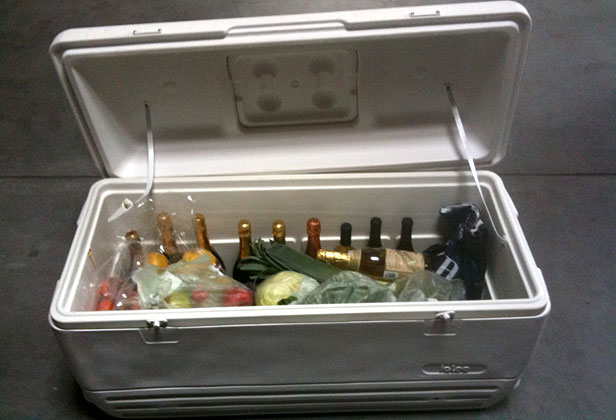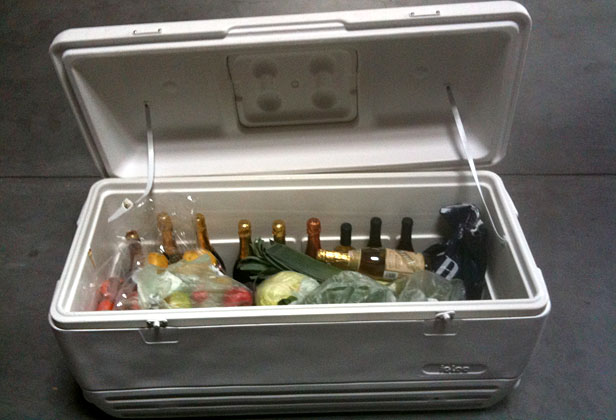 Lush for life: Yes, my family likes to enjoy the bubbles around the holidays.Photo: Bonnie Powell
Lush for life: Yes, my family likes to enjoy the bubbles around the holidays.Photo: Bonnie Powell
A few weeks ago, my spare side-by-side fridge/freezer up and died. I was (and remain) pissed about this. It’s a fancy-pants Samsung, about four years old, and the Sears repair guy said the compressor would cost $800 to fix — 75% of what the fridge was new. “Samsung’s great for TVs; crap for fridges,” he said.
Why do I have a spare fridge? Well, three adults and one baby live here, and I cook a lot, far more often than I feel like shopping. But mainly because I run a couple of Community Supported Agriculture programs for local farms. Twice a month, I host pickups, and inevitably end up having to store the orders of people who forget to or can’t pick up their shares.
But I have long felt guilty about this energy vampire squatting out there in all its faux-stainless-steel glory in our garage. The freezer’s full, but the fridge itself is usually empty, except for alcohol. I told myself it was OK because at least it was energy-efficient. When it broke, I started checking out chest freezers, thinking that made more sense.
And then I read David Owen’s much-discussed recent piece in the New Yorker, “The Efficiency Dilemma” [$ub req]. Owen resurrects a 19th-century economic hypothesis called the Jevons paradox, which states that improvements in energy efficiency are canceled out by falling prices that increase consumption in a “rebound effect.” (One Grist contributor argues that rising incomes are more to blame; another thinks Owen is spot on.) His main example is air-conditioning: when it used to be expensive, few families had it, and those that did ran it sparingly. Now it’s in every car and every office building — he says roughly as much electricity goes to cooling buildings as America used for all purposes in 1955.
He also talks about cooling as it applies to food, although not the massive energy suck represented by our elaborate centralized distribution model that allows California produce to be sold in snowbound East Coast supermarkets days later. (See Tom Philpott’s bulleted explanation of where the most energy gets used in the food chain.) Owen focuses on consumers’ gluttonous appetite for cold food storage:
A good way to see this is to think about refrigerators, the very appliances that the World Economic Forum and Steven Chu cited as efficiency role models for reductions in energy use. The first refrigerator I remember is the one my parents owned when I was little. They acquired it when they bought their first house, in 1954, a year before I was born. It had a tiny, uninsulated freezer compartment, which seldom contained much more than a few aluminum ice trays and a burrow-like mantle of frost. (Frost-free freezers stay frost-free by periodically heating their cooling elements–a trick that wasn’t widely in use yet.) In the sixties, my parents bought a much improved model — which presumably was more efficient, since the door closed tight, by means of a rubberized magnetic seal rather than a mechanical latch. But our power consumption didn’t fall, because the old refrigerator didn’t go out of service; it moved into our basement, where it remained plugged in for a further 25 years — mostly as a warehouse for beverages and leftovers — and where it was soon joined by a stand-alone freezer.
This escalation of cooling capacity has occurred all over suburban America. The recently remodelled kitchen of a friend of mine contains an enormous side-by-side refrigerator, and a drawer-like under-counter mini-fridge for beverages.
Meanwhile, hotel mini-fridges sit there cooling cans of Coke and little tiny bottles of alcohol all over the country, he points out. The madness!
Not only do all these home fridges and freezers burn fossil fuels, but they encourage food waste, by tempting us to fill them up with perishables that go bad before we get around to using them. Writes Owen:
And when we throw away food we don’t just throw away nutrients; we also throw away the energy we used in keeping it cold as we lost interest in it, as well as the energy that went into growing, harvesting, processing, and transporting it, along with its proportional share of our staggering national consumption of fertilizer, pesticides, irrigation water, packaging, and landfill capacity. According to a 2009 study, more than a quarter of U.S. freshwater use goes into producing food that is later discarded.
Now, I don’t throw away food; on the rare occasions something has reached the rotten stage in my fridge, it at least goes in the compost. And I am notorious for cooking, eating, and even serving food that has seen far better days. (What’s a little mold on your cheese or slime on your beef?)
But Owen is right. The fact that my spare fridge was only costing me a few bucks a month was why I’d kept it.
I’ve decided I won’t be replacing it. Instead, I’ll start stocking my freezer more judiciously, and use a cooler in the garage for those times, like holidays, when I need overflow cold storage. It’s about 50 degrees out there anyway, and the frozen leg of lamb and the ham I’m defrosting are keeping all the Prosecco and the vegetables cold. And it’s kilowatt-free.



